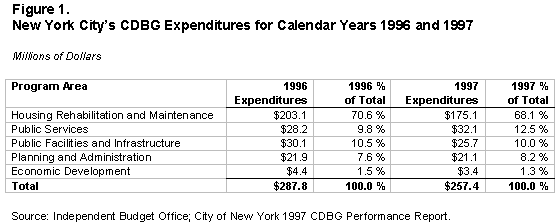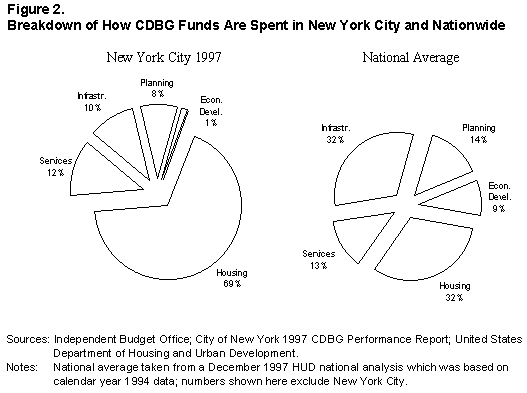
INDEPENDENT BUDGET OFFICE
The City of New York
110 WILLIAM STREET, 14TH FL., NEW YORK, NY 10038
New York City's Use of Community
Development Block Grant Funds

INDEPENDENT BUDGET OFFICE
The City of New York
110 WILLIAM STREET, 14TH FL., NEW YORK, NY 10038
New York City's Use of Community
Development Block Grant Funds
On April 1 1998, the City of New York released its calendar year 1997 Community Development Block Grant (CDBG) Performance Report, which highlights how the city spent $257 million in CDBG funds. IBO's analysis of the report shows that New York City spends 68 percent of this federal grant on the rehabilitation and maintenance of housing. New York City's allocation, reflecting its large stock of in rem housing, varies significantly from the national average. Nationally, municipalities typically spend a much smaller portion of their CDBG funds on housing rehabilitation and maintenance and more of the grant on public services, public facilities and infrastructure, and economic development initiatives.
Background. The Community Development Block Grant program was established by Congress through the Housing and Community Development Act of 1974 to fund a wide range of activities directed toward revitalizing neighborhoods and promoting economic development. Awarded as an annual grant to municipalities by the United States Department of Housing and Urban Development (HUD), the CDBG program allows communities to develop their own funding priorities but requires that they give precedence to activities which benefit low- and moderate-income persons. In general, municipalities are allowed to use the grant to fund housing rehabilitation and maintenance, public services, public facilities and infrastructure improvements, economic development activities and related planning and administrative costs.
How New York City Spends its CDBG. Revenue received by New York City through the CDBG program supports activities at 19 different agencies and accounts for about 6 percent of the city's federal categorical aid. In calendar year 1997, the city spent $257 million in CDBG funds. As shown in Figure 1, IBO's analysis of the 1997 CDBG expenditures shows that $175.1 million, or 68 percent of total, was spent on housing rehabilitation and maintenance. This was followed by expenditures on public services (12.5 percent), public facilities and infrastructure (10 percent), and planning and administration (8.2 percent). About 1 percent of the total was spent on economic development initiatives. New York City's 1996 CDBG programmatic allocation was very similar to the city's 1997 CDBG expenditures.

The following highlights the city's 1997 CDBG expenditures in greater detail:
- Housing Rehabilitation and Maintenance ($175.1 million):
Of the amount expended by the city in this area, $142.8 million was used for the maintenance and rehabilitation of city-owned (in rem) housing units, $29.6 million was spent on privately-owned buildings, and the remainder was used to support public housing projects and residential historic preservation.
- Public Services ($32.1 million):
The funding of homeless shelter operations accounted for $16.9 million of the city's CDBG public services expenditures in 1997, with $13.7 million of these dollars supporting security services at homeless shelters. Support for victims services programs, including counseling and a crime victims hotline, accounted for $3.8 million of total expenses, followed by assistance for child care services and park operations, at $3.1 million each. The remaining expenditures were divided among cultural affairs, human rights, and youth programs.
- Public Facilities and Infrastructure Improvements ($25.7 million):
Of the funds expended by the city for public facilities and infrastructure improvements, $11.2 million was used for vacant lot clean-up and reclamation, $9.2 million for day care center enhancements, and $2.9 million for homeless facility renovations. The remainder was used to address code violations in schools and improve various neighborhood facilities.
- Planning and Administration ($21.1 million):
Of the CDBG funds spent by the city in this area, $11.6 million funded planning, policy analysis and research, mainly to support comprehensive planning activities and geographic systems at the Department of City Planning. The remaining $9.5 million supported administrative functions, predominately at the Department of Housing Preservation and Development.
- Economic Development ($3.4 million):
In 1997, providing technical and capital assistance funds to community based organizations and local development corporations accounted for $2.2 million of city's CDBG economic development expenditures. The remainder funded a program to improve the marketability and attractiveness of industrial areas in the city.National Benchmarks. According to data from HUD, the nationwide profile of how CDBG funds are spent varies greatly from New York City's profile. HUD's latest nationwide comparison was for the 1994 calendar year and shows that nationally there is a much more even distribution of CDBG expenditures over program areas than in New York City. As shown in Figure 2, nationwide (excluding New York City), municipalities spent 32 percent of the grant on housing rehabilitation and maintenance, 32 percent on public facilities and infrastructure repairs, 14 percent on planning and administration, 13 percent on public services, and 9 percent on economic development activities.

The disparity between the New York City and the national CDBG expenditure profiles highlights the fact that New York City has the largest stock of in rem housing units in the country. Although there is now a moratorium on acquiring new in rem properties, at the end of fiscal year 1997 there were 30,475 units in the Department of Housing Preservation and Development's Central Management in rem portfolio. In addition to the moratorium, the city has implemented several initiatives to sell units and reduce the financial and administrative burden of housing rehabilitation and maintenance. Because of these initiatives, it is estimated in the Mayor's 1998 Preliminary Management Report that by the end of fiscal year 1998, the number of Central Management in rem units will decrease to 27,059. This should allow some of the CDBG funds now used for housing rehabilitation and maintenance to be utilized for other purposes in the future.
The IBO will continue to follow how the city spends its federal Community Development Block Grant funds both programmatically and geographically. In the future, look for an IBO analysis which will provide site specific information on CDBG programs and a borough by borough analysis of each program area.
For more information on this topic or for a more detailed breakdown of CDBG expenditures, please call Bill Kramer, Budget and Policy Analyst, at 212-442-0332.